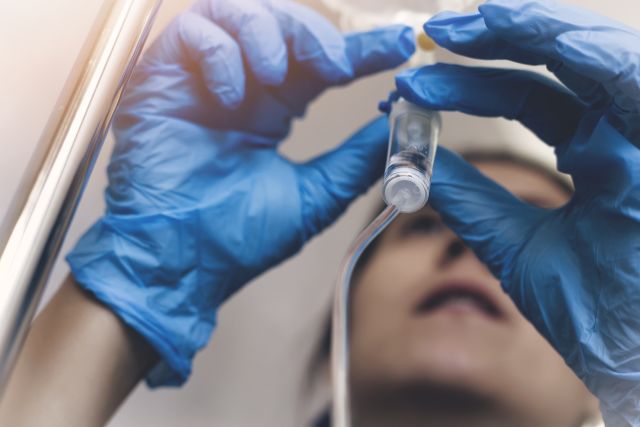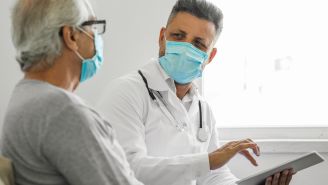Updated on November 5, 2020.
Five years ago, Heather Cramer began battling stage 4 metastatic breast cancer. After receiving 16 rounds of chemotherapy and undergoing a mastectomy, the 34-year-old wife and mother of three achieved remission from her disease.
But in early 2019, Cramer noticed mosquito bite-like bumps on her breast that turned out to be triple-negative breast cancer—a different form of the disease that spread to her lungs, bones and brain.
Since the spring of 2020, around the time the COVID-19 pandemic erupted, Cramer has been through precision radiation therapy to treat parts of the tumor in her brain. She has been hospitalized and undergone surgery for a breast infection. She’s also had repeat trips to the emergency room for complications related to her treatment.
Most of the time, she has shouldered these experiences alone.
“COVID has thrown a wrench into things and made it harder to manage my care, physically, emotionally and mentally all around,” Cramer says. “During those tough times, it would have been nice to have somebody there to help me through the pain or hold my hand.”
Facing cancer treatment alone
Many people with cancer have weakened immune systems, either due to the cancer itself or as a result of treatments, such as radiation and chemotherapy.
This puts them at increased risk for severe COVID-19. For a July 2020 review published in Hematology/Oncology and Stem Cell Therapy, researchers analyzed results from 22 different studies about cancer and COVID-19. They found that patients with cancer had an almost four times greater risk of severe COVID-19 and about a three times greater risk of death from COVID-19, compared to patients without cancer.
In order to decrease the risk of exposure to COVID-19, cancer centers have had to impose a range of precautions.
At The Ohio State University Comprehensive Cancer Center, where Cramer travels almost two hours each way for her weekly treatments (and sometimes more often for scans and tests), visitors are not allowed at clinic appointments or at treatment visits. Only one visitor is allowed during hospitalizations, and only during limited hours.
Since her diagnosis in 2019, Cramer has received various cancer treatments, none of which have been successful. She recently began a new targeted drug therapy, which is the first of its kind to be approved by the U.S. Food and Drug Administration (FDA).
“Nobody could be with me through any of it, so it was hard,” Cramer admits. “I had to go through it alone, hearing that the treatment wasn’t working anymore and that I needed to start a new treatment. I can call or FaceTime so they can be part of it, but that’s hard, too.”
Many cancer centers have made exceptions to account for special circumstances. At Ohio State, certain patients may have a visitor if they are going to an appointment to discuss a first diagnosis, or if they may be hearing tough news. This is particularly important since some people must travel long distances—even out of state—for cancer treatment.
Visitors may also accompany patients with cognitive difficulties who might not understand what their doctor says to them. Patients who are in the hospital for surgery are also able to have a visitor outside of normal visiting hours.
The added burden of COVID-19
Facing a life-threatening medical diagnosis is difficult under normal circumstances. COVID-19 has only added to the overwhelming burden.
Aside from the psychological strain, patients with cancer may also face financial hardship due to the economic fallout from the pandemic, according to Cramer’s oncologist, Sagar Sardesai, MBBS.
Many people who have lost their jobs have also lost their medical insurance while struggling to pay for cancer care.
“Besides the physical burden, there are uncertainties, anxieties and an emotional burden associated with a diagnosis of cancer. Patients with cancer are facing these challenges often alone,” Dr. Sardesai explains. “The psychosocial aspects of what COVID-19 is doing to the general public is intensified for cancer patients.”
The struggle to stay connected
COVID-19 has taken a toll on the mental health and well-being of millions around the world. For many people, social distancing and lockdown restrictions necessary to contain the pandemic have led to increased social isolation and decreased social connectedness.
This ongoing isolation can have negative effects—even for those who aren’t facing a serious medical issue. Mounting research has shown that social isolation can have wide-ranging effects, including worse mental and physical health.
The social toll of COVID-19, however, may be even heavier for certain groups of people, including cancer patients like Cramer. She says that COVID-19 has disrupted most other areas of her life outside of cancer treatment, particularly her social life.
In the rural area of Ohio where Cramer lives and works full-time as a school treasurer, she, her husband and her three sons—ages 8, 11 and 13—have all had to take extra precautions to avoid exposure to the coronavirus.
“COVID has kept me from doing the normal things like going to the grocery store or hanging out with friends or going out to eat. All the things that make life enjoyable,” Cramer says.
Despite being forced to remain vigilant about maintaining distance from others since receiving her diagnosis, she can still find a reason to be grateful.
“One thing COVID has blessed me with is spending a lot more time with my kids and my husband because we don’t really go out to do much else,” Cramer adds.
How everyone can help ease the strain
There is no easy remedy to ease the uncertainty of the pandemic or a difficult cancer diagnosis. But there are ways that people can help those facing a health battle, and in turn, support their own health and well-being.
One simple but critical step that everyone can take is to wear a mask or cloth face covering when out in public or around others to curb the spread of COVID-19.
Cramer says she wishes everyone could have just a bit more empathy when it comes to this preventive measure, which she sees as a medical issue—not a partisan one.
“I don’t hold anything against anybody who doesn’t want to wear a mask, but in my mind it’s not political,” she says.
Mounting research also suggests that small acts of kindness can make a big difference when it comes to improving your quality of life and the well-being of your community.
Lending your time by volunteering, even virtually, may help. A June 2020 study published in the American Journal of Preventive Medicine found that older adults age 50-years and older who volunteered for 100 hours or more per year had a lower risk of death and improved physical functioning. They also felt more optimistic and had a stronger sense of purpose in life.
Thoughtful gestures can mean a lot to someone who’s battling cancer or other challenges during the pandemic. And you can help—even if you’re wearing a mask, Sardesai points out.
“Simple things, any kind gesture would not go unnoticed for patients who are fighting a difficult disease like cancer,” he says. “There are different ways of being innovative and finding ways to reach out to people. These things would be so appreciated by patients with cancer. They need it no matter how good their support system.”







